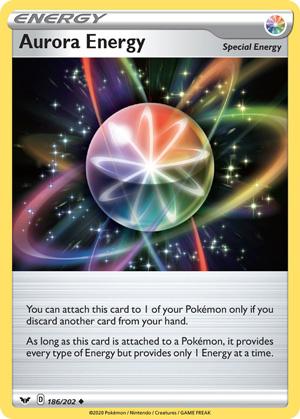
Aurora Energy – Sword and Shield
Date Reviewed: January 15, 2021
Ratings Summary:
Standard: 3.25
Expanded: 3.00
Limited: 4.00
Ratings are based on a 1 to 5 scale. 1 is horrible. 3 is average. 5 is great.
Reviews Below:

Otaku
Back to Honorable Mentions, up next is Aurora Energy (Sword & Shield 186/202). It states you may only attach it to one of your Pokémon if you discard a card from your hand. Aurora Energy is a Special Energy card that, while attached to a Pokémon, provides one unit of Energy which counts as all Energy types. We first reviewed it back in February, as the 4th best card of Sword & Shield. This is not a new effect; Rainbow Energy brought it to the game all the way back in 2000. Rainbow Energy does do things a little differently; it still provides a unit of Energy that counts as all types, but instead of requiring you discard a card from hand to play it, Rainbow Energy (post-errata) places a damage counter on the Pokémon to which you attached it.
Aurora Energy is not everywhere. Why? If you don’t need multiple Energy types in a single deck, you don’t need Aurora Energy. Aurora Energy released before Rainbow Energy rotated from the Standard Format, so some decks stuck with Rainbow Energy, some switched to Aurora Energy, and a few had the need to run both. However, only a few successful decks are using Aurora Energy now. Why? They either
- Run on a single basic Energy type
- Are better off just using a second kind of basic Energy
The various supporting effects for Energy cards usually only work for basic Energy cards. Some of the anti-Energy effects only affect Special Energy cards. Put it together, and a deck such as Zacian V/Arceus & Dialga & Palkia-GX is just better off sticking with Water Energy for its non-Metal Energy needs.
That doesn’t mean Aurora Energy is bad. It just means there isn’t as much of a need for it right now. It is still seeing some success in Standard… and also in Expanded. The latter is rather telling, as it not only is competing with Rainbow Energy, but the Blend Energy series, Counter Energy, Prism Energy, the Unit Energy series, and a few even more Specialized offerings. There are definitely times when discarding a card from hand barely matters, or is even a fringe benefit… and when conditions, restrictions, or costs of the other options are a concern. In the Limited Format, pulling an Aurora Energy is usually a must-run. If you’re running a mono-type deck, then you can skip it… unless you want to mislead your opponent. You’ll often need to run multiple different types of Energy in your Limited Format decks, and Aurora Energy makes it easier.
Ratings
- Standard: 3/5
- Expanded: 3/5
- Limited: 4/5
Bye now, I thought Aurora Energy would have been more distinguished, but the metagame went in a direction unfavorable to it. Aurora Energy still does its job, and there’s a solid chance it will spike up to a four-out-of-five card before it passes on into Expanded-only territory.

Vince
Aurora Energy debuted in the Sword & Shield base set, and it was the 4th best card of the set when we first reviewed it. This is a Special Energy card which requires you to discard a card from your hand first in order to attach it to one of your Pokemon. It then provides one unit of energy that can provide any type of Energy. This seemed to be the successor of Rainbow Energy, as it was last printed in the Sun & Moon Celestial Storm expansions, thus leaving the 2019-2020 Standard rotation.
Some of the reasons why Rainbow Energy was an incredible card back in the day – and it still is now – is due to its flexibility. Most decks would stick to one energy type so that they don’t have to deal with having the wrong energy or the wrong attacker at the wrong time. But what if players absolutely need to run multiple attackers with different energy types? Then Rainbow Energy is one of the best solutions! No matter who you start with, Rainbow Energy will at least help meet one of the energy requirements. Even though you’re limited to have only four copies of Rainbow Energy, this is still enough to help you meet certain attack costs. The self-damage was actually a big deal back then when HP scores were significantly low at the time, but now it isn’t too much to bear. Still, a measly one damage counters can be the difference between surviving a hit, or being OHKOed, even at 340 HP.
Rainbow Energy has helped a lot of decks that ran several Pokémon with different energy costs. The most blatant example of a deck that greatly utilize Rainbow Energy to the fullest extent is none other than Ross Cawthon’s The Truth, whose deck made it to second place in the 2011 World Championships Master Division, only defeated by David Cohen’s TwinBoar. Ross’s deck has at least three attackers despite a deck having 26 Pokémon. Zekrom, Entei & Suicune LEGEND, and Donphan Prime were attackers that can dish out a lot of damage, and those attack costs require Fire, Water, Fighting, and Lightning energies! I don’t know any deck right now that can even afford to run inconsistent lines, but the possibility is there.
Not only Rainbow Energy does that, but it was frequently run in conjunction of Special Darkness Energy or Special Metal Energy. During the period between the Neo-era until the ex-era, there were no basic Darkness or basic Metal energies, so decks that uses Metal or Darkness Pokemon will most likely have special energies. This may not be a good thing, unfortunately, as anti-Special energy does exist in some form. That was before; For the Expanded format, Rainbow Energy isn’t needed in every deck, but it sometimes see some play. I was gonna mention that it would have helped Dragon types whose attack cost require at least two different energy types, but they already have Double Dragon Energy for that.
It’s getting to the point where I can’t say that Aurora Energy is either better nor inferior to Rainbow Energy. During the time Aurora Energy debuted, Rainbow Energy was still in the format, and having an equivalent of up to eight Rainbow Energies in a deck sounds juicy, and Porygon-Z can help whatever Pokémon you want to use regardless of attack costs. Pretty much it comes down to whichever cost you feel like you can pay. Well, your only option in Standard is to discard a card from your hand, but Expanded has you decide between discarding a card from your hand or take 10 damage on the Pokémon you’re about to attach to. Personally, I liked both of these costs despite the drawbacks, though I would benefit more from discarding a card from my hand either because there’s certain combos associated with the discard pile or that I would discard them anyways when playing Professor’s Research.
Ratings:
Standard: 3.5/5
Expanded: 3/5
I realized that I’ve made a dual review of both Rainbow Energy and Aurora Energy because they provide the same thing, albeit with different costs. The Standard Format needs at least one Special Energy card that can provide one energy of any type, and Aurora Energy does just that.
We would love more volunteers to help us with our Card of the Day reviews. If you want to share your ideas on cards with other fans, feel free to drop us an email. We’d be happy to link back to your blog / YouTube Channel / etc. 😉Click here to read our Pokémon Card of the Day Archive. We have reviewed more than 3500 Pokemon cards over the last 17+ years!



